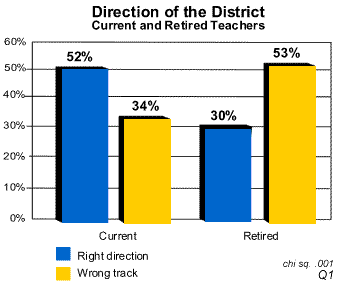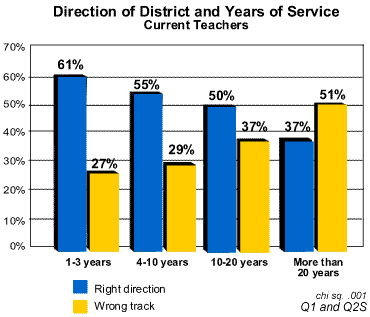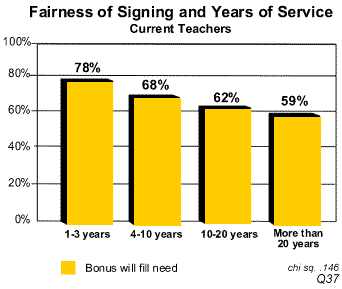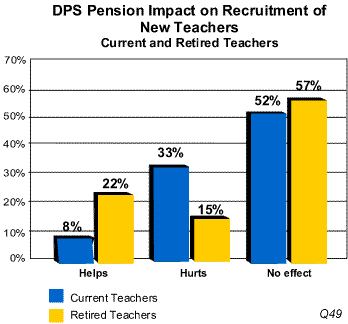Findings and Analysis
The following are the findings and analyses from a March 2002 survey of 300 current and 102 retired Denver Public Schools teachers. The section is arranged to present the data as the discussion took place with respondents. The order is current and future strengths and weaknesses of DPS; important factors in recruiting teachers; employment conditions and compensation such as bonus pay, pensions and HR; and finally, rating other metro area school districts.
A. Future of District
By a slight majority (52%) current DPS teachers believe the school district is “going in the right direction” (34% believe it’s on the wrong track). That contrasts with recently retired teachers, a majority (53%) of whom believe the district is on the wrong track (30% believe it’s going in the right direction). Examine specific wording used in the questionnaire in Section V beginning on page 23. (Q1)

- Gender is not a factor in attitudes about the future of DPS. Current and retired teachers, and men and women are within one point of each other in evaluating the direction of the district.
- Black teachers both current (45% wrong track) and retired (75% wrong track), are more pessimistic about the direction of DPS.
- The longer teachers work for DPS, the less optimistic they are about its future direction. Among new teachers (1 to 3 years), 61% believe DPS is moving in the right direction. But among teachers with more than 20 years of service, only 37% believe DPS is moving in the right direction; 51% believe it’s on the wrong track.

- Teachers in schools rated unsatisfactory by CSAP scores are less optimistic (44% right direction and 38% wrong track).
- High school teachers are slightly more up-beat about the district (57% right direction) but middle school teachers are more pessimistic (49% right direction) about DPS’s direction.
When asked specifically about the likelihood of improvement the next two years given recent changes in the district (new leadership, reorganization, new accountability rules and procedures), 36% of teachers believe there will be some or considerable improvement and 39% feel things will be about the same; 19% think things will get worse. Retirees continue to be more pessimistic; only 27% believe improvement is likely (47% say about the same and 22% think things will get worse). (Q2)
B. DPS Teaching Environent
Teachers give few positive ratings to DPS for factors important to the teaching and educational environment. The contribution of para-professionals garners the highest excellent rating at 19%. The quality of principals receives a 10% excellent rating. In general, scores are low.
Table 5
Rating Factors in DPS Effecting Teaching
and Educational Environment
Current Teachers
|
| Factors |
Excellent |
Excellent and
Good |
Poor |
| The contribution of para-professionals to student achievement |
19% |
53% |
15% |
| Quality of principals in DPS |
10% |
58% |
9% |
| Availability of textbooks |
9% |
47% |
21% |
| The availability of classroom supplies other than textbooks |
9% |
42% |
28% |
| The level of preparedness of new teachers from teacher college programs |
7% |
53% |
10% |
| Effectiveness of CDMs (Collaborative Decision-Making committees) |
5% |
38% |
22% |
| The level of preparedness of teachers from the Teacher-In-Residence program |
4% |
31% |
15% |
| The level of support from central administration |
3% |
22% |
32% |
|
Q3 to Q10 |
- Rated especially poor are support from central administration (32% poor rating), availability of supplies (28% poor) and textbooks (21% poor), and effectiveness of CDMs (22% poor). (Q3 to Q10)
- New teachers are the most supportive of principals (68% excellent or good). They are most concerned about supplies other than text books (40% poor). (Q3 and Q6)
- Senior teachers give low ratings to CDMs (31% poor compared to 22% average) and central administration (39% poor compared to 32% average). (Q4 and Q5)
- Para professionals receive their strongest vote of support from elementary school teachers (60% excellent or good) and teachers in schools rated excellent or high on CSAP (72% excellent or good). (Q7)
C. Importance of Recruiting
Both current and retired teachers judge recruiting and retaining “high quality teachers” in low-performing schools as critical (88% and 89% very important, respectively). Two-thirds of current teachers (65%) say recruiting is a top priority at their present school. (Q11 and Q12)

- More than two thirds (69%) of teachers at unsatisfactory schools said recruiting teachers was a top priority at their current school.
D. California Recruiting
California school districts are recruiting in Colorado. The package of incentives they are offering was tested with DPS teachers. The offers to limit class size to 20 in grades K through 3 and forgiving college student loans are rated as the most powerful incentives (73% and 76% rated them “very powerful,” respectively). (Q13 to Q20)
Table 6
California Teacher Incentives
Current and Retired Teachers
|
|
VERY POWERFUL |
| Incentives |
Current
Teachers |
Retired
Teachers |
| College student loans are forgiven |
76% |
76% |
| lass size is limited to 20 in K through 3 |
73% |
79% |
| Relocation payment for moving expenses |
57% |
55% |
| Salary in first 5 years increased quickly |
57% |
66% |
| Tax credit for working in low-performing school |
56% |
54% |
| Signing bonus of $3,000 |
44% |
43% |
| Starting pay is $35,500 |
42% |
53% |
| Quality of California lifestyle |
13% |
10% |
|
Q13 to Q20 |
California itself is not seen as an especially potent attraction (only 13% rated it “very powerful”). Other monetary incentives seen as powerful by more than half of current teachers: rapid salary increases in the first five years, relocation payments and tax credits for working in low-performing schools (57%, 57% and 56%, respectively). (Q13 to Q20)
- New teachers are especially attracted to forgiveness of college loans (86% “very powerful”) and relocation payments (64% “very powerful”).
- Teachers in unsatisfactory performing schools liked the tax credit for working in low performing schools (70% “very powerful”) and new teacher relocation payments (64% “very powerful”).
E. Recruiting Factors
When asked to rate a list of 10 factors which educational research identifies as significant to recruitment, current and retired teachers agree that class size, starting salary, health benefits and the building principal are top factors in recruiting new teachers. (Q21 to Q30)
-
Table 7
Top Factors Effecting Recruitment
Current and Retired Teachers
|
|
TOP FACTOR |
| Factors |
Current
Teachers |
Retired
Teachers |
| Class size |
80% |
79% |
| Health benefits |
76% |
85% |
| Starting salary |
74% |
76% |
| The building principal |
74% |
74% |
| Knowledge of school assignment |
67% |
63% |
| Pension plan |
67% |
78% |
| Reputation of school assigned to |
45% |
54% |
| Reputation of DPS in general |
42% |
52% |
| Housing cost in metro area |
38% |
34% |
| Length of commute from home to school |
33% |
30% |
|
Q21 to Q30 |
- New teachers rate the importance of knowledge of class assignment (71%) higher than do current teachers (67%). (Q24)
Starting salary is tops among both groups when asked to choose one among the 10 factors. However, among current new teachers, class size rates closer to starting salary than it does for current or retired teachers. Senior teachers (20 years or more) believe by more than 4 to 1 that money is the prime factor over class size. (Q31)
F. Why Teachers Leave the System
Current teachers say the primary reason their fellow teachers quit the system are administrative problems and lack of leadership (32%) (view the specific responses on page 36 of the questionnaire, Section V). They also believe salary (15%), class size (14%), student attitudes (12%) and simple burn out (11%) are major reasons for leaving DPS. After combining similar reasons for leaving the district it is clear teachers consider their level of support from education leaders the main problem. Working conditions, such as class size and work load, is the second most significant issue. The stress of student and parent attitudes in an urban setting is the third factor. Compensation comes in fourth. (Q32)
- Middle school teachers are the most concerned with administrative problems that cause fellow teachers to leave the profession.
- High school teachers (20%) and those in unsatisfactory rated schools (21%) most often cite “student attitudes” as driving teachers out of DPS.
- Both men and women cite the administration as the biggest problem (30% and 33% respectively) but men give more weight to salary (18%) than class size (8%). Women consider class size (15%) slightly ahead of salary (14%) as the major cause of leaving the system.
G. Bonus Pay
If a school is given a $50,000 grant to recruit highly qualified teachers, the top recommendation of current teachers for spending the money is to offer signing bonuses.
Table 8
$50,000 Grant tp Attract High Quality Teachers
|
|
TOP FACTOR |
| Spend Money On… |
Current
Teachers |
Retired
Teachers |
New
Teachers |
Unsatisfactory
CSAP |
| Signing bonus |
22% |
12% |
23% |
30% |
| Teaching supplies |
19% |
24% |
22% |
21% |
| Pay raises |
13% |
4% |
10% |
16% |
| Smaller class size |
11% |
17% |
10% |
8% |
| Teacher assistants |
9% |
13% |
6% |
5% |
| Workshop training |
9% |
9% |
6% |
14% |
| Performance pay |
9% |
7% |
7% |
6% |
| Yearly bonus |
8% |
3% |
9% |
9% |
| Top eight recommendations |
Q33 |
- New teachers (1 to 3 years) and teachers in unsatisfactorily rated schools agree that signing bonuses will help. Their second place choice is teaching supplies. Retired teachers suggest teaching supplies (the second choice of current teachers) as a first choice and smaller class size as second. (Q33)
Signing and annual bonus amounts were tested with teachers; and $5,000 is the amount most often mentioned as the minimum needed to attract a new teacher to a low-performing school. Both retired and current teachers believe if an annual bonus is offered to teachers in low-performing schools, it should be $3,000 to $5,000. (Q34 and Q35)
-
Table 9
Signing and Annual Bonus
Current and Retired Teachers
|
|
SIGNING BONUS |
ANNUAL BONUS |
| Bonus Amount |
Current
Teachers |
Retired
Teachers |
Current
Teachers |
Retired
Teachers |
| $1,000 |
-- |
-- |
10% |
8% |
| $2,000 |
12% |
8% |
13% |
17% |
| $3,000 |
16% |
12% |
24% |
26% |
| $5,000 |
46% |
43% |
29% |
22% |
| $10,000 |
11% |
17% |
13% |
15% |
| $20,000 |
9% |
10% |
-- |
-- |
| No to all |
3% |
4% |
6% |
7% |
| Don’t know to all |
4% |
7% |
5% |
7% |
$1,000 not asked for signing bonus and $20,000 not asked for annual bonus |
|
Q34 and Q35 |
- Teachers in “excellent” and “high” CSAP-rated schools believe both signing bonuses and annual increases need to be higher; e.g., $10,000 signing bonus. Also, men and more senior teachers support higher payments as need to attract teachers. (Q34 and Q35)
Asked specifically about the fairness of giving bonuses to teachers in low-performing schools, two-thirds of current teachers (68%) approve it and agree “Not all pay has to be within the salary schedule” (66% of retired teachers approve). (Q37)
-

- Younger teachers (78%) are the most supportive of the signing bonus as are high school teachers (77%).
- In general, teachers claim to be competition averse. They agree (79% current, 83% retired) “performance pay will hurt cooperation among teachers” and reject the statement “teacher performance pay will encourage greater effort and reward those who do a superior job (19% current, 13% retired).” Newer teachers (1-3 years, 23%, 4-10 years, 33%) and high school teachers (31%) give slightly greater support to performance pay. (Q36)
- Retired teachers overwhelmingly “strongly agree” (86%) that “teachers don’t like to judge other teachers’ performance to determine pay.” Only 3% disagree (strongly and somewhat). Current teachers are slightly less committed to that position; 61% strongly agree and 15% disagree (strongly and somewhat). Fifty-four percent of new teachers and those in unsatisfactory schools strongly agree with the statement. (Q56)
H. Working Conditions
Improving working conditions is equally important to improving pay. Seventy-five percent of current teachers think a turnkey package of benefits, including a signing bonus, para-professionals, adequate supplies, more planning time and freedom from non-teaching duties, is a “very powerful” incentive to attract good teachers. (Q38)
- 83% of new teachers rated the turnkey package “very powerful.”
- 61% of current and 68% of retired teachers strongly agree “more money would help recruitment and retention but better overall working conditions are more important.” (Q55)
I. Test Scores/CSAP
CSAP tests are generally disliked by teachers for a variety of reasons. However, most teachers believe that if CSAP scores increase even slightly, it will improve morale and the reputation of DPS (77% current teachers agree; 36% strongly and 41% somewhat). (Q54)

- The following groups are more likely to agree a CSAP score increase would improve morale: black teachers (65% strongly agree); more senior (10 years or more) teachers (40% strongly agree); high school teachers (43% strongly agree); teachers in unsatisfactory rated schools (41% strongly agree).
J. Human Resources Department
DPS’s Human Resources Department (HR) receives mostly “only fair” to “ poor” ratings from current and retired teachers for its main recruiting duties. The lowest ratings are for “informing teachers of their assignments before the school year begins,” “matching teachers into assignments in which they have some preparation,” and “follow-up on inquires and questions.” Only in “presenting DPS as a good place to work” does HR reach 50% “excellent” or “good” ratings. (Q39 to Q43)
Table 10
Rating Human Resources Department Duties
Current Teachers
|
| Duties |
Excellent |
Excellent and
Good |
Poor |
| In general, presenting DPS as a good place to work |
12% |
53% |
12% |
| Placing new teachers into the assignment promised |
11% |
48% |
7% |
| Telling new teachers their assignment in ample time before the school year begins |
10% |
34% |
22% |
| Placing new teachers in assignments for which they have some preparation and background |
9% |
42% |
17% |
| Following up to address new teachers’ inquires and questions |
7% |
32% |
24% |
|
Q39 to Q43 |
- In an additional set of questions regarding support for a new teacher once placed in a school, Human Resources is rated “only fair” or “poor” by a majority of teachers in providing start-up training, strong mentors or coaches and classroom supplies. Only “providing continuing professional development” receives a majority (barely) of good and excellent ratings (56%). (Q44 to Q47)
- New teachers (1-3 years), who have recently experienced the HR Department firsthand, are somewhat more positive in their ratings, and provide an average 3% to 10% higher “excellent” ratings. The exception is in providing classroom supplies, of which new teachers (38% poor compared to an average of 26%) and teachers in unsatisfactory rated schools (33% poor) are especially critical.
K. Pension System
Current DPS teachers are substantially less satisfied with the pension system than their retired counterparts. Only 21% of current teachers say the system is better and 28% say it is worse than other school districts using the state system. But 56% of retired teachers say it is better and only 8% rate it worse. (Q48)

- New teachers (1 to 3 years) are strongly hostile to the DPS pension plan. Thirty-four percent believe it is worse than the state system, compared to 28% of all current teachers and 16% of those in the system 20 years or more.
A majority of both current and retired teachers say the pension system has no effect on recruiting new teachers (52% current and 57% retired). But the minority disagrees about its impact on recruitment; 22% of retirees say it helps recruitment, compared to just 8% of current teachers. A third of current teachers and 15% of retirees say it hurts. (Q49)

- Also new teachers (36%) are more likely than longer-serving teachers (22%) to believe it hurts recruiting.
L. Rating Metro School Districts
Current and retired teachers are in agreement that Cherry Creek Schools deserve the highest favorable rating among four metro districts tested. Denver is rated close to Jefferson County Public Schools. Many DPS teachers do not know enough about Aurora to give it a rating (28% don’t know). (Q50 to Q53)
-
Table 11
Favorability Rating of
Metro School Districts
(Lowest score=highest rating)
Current and Retired Teachers
|
|
MEAN SCORE |
| DISTRICT |
Currnet
Teachers |
Retired
Teachers |
| Cherry Creek |
1.6 |
1.5 |
| Jefferson |
1.9 |
2.0 |
| Denver Public Schools |
2.1 |
2.3 |
| Aurora |
2.5 |
2.4 |
| Q50 to Q53 |
- Current senior teachers (more than 20 years) and Anglo teachers rate Cherry Creek Schools more favorably than do all current teachers (1.5 senior, 1.5 Anglo).
- Not surprising, current teachers in DPS’s highest and lowest rated schools give DPS its highest and lowest ratings, respectively (1.9 excellent/high, 2.1 unsatisfactory).
<< Back
[top] [archives] [home] [send this page to a friend] |